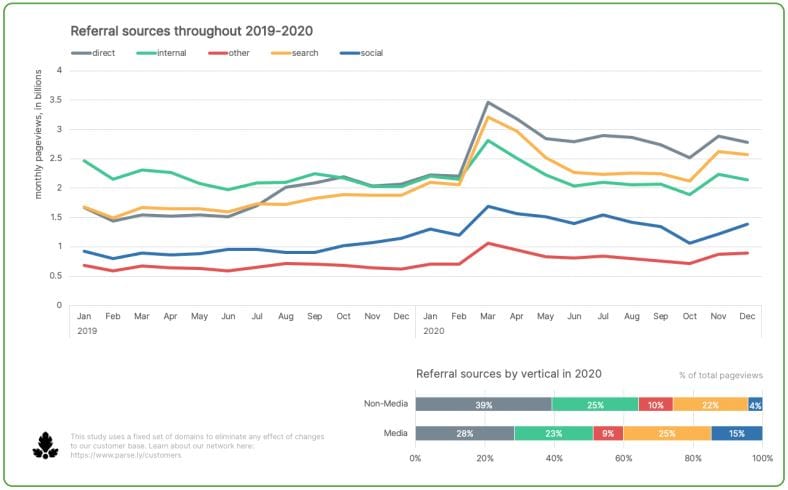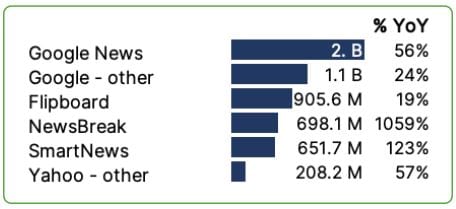|
Getting your Trinity Audio player ready...
|
Parse.ly, the content analytics platform recently acquired by WordPress.com owner Automattic, has just released its report on the major content trends it’s seen over the past twelve months, one of the most transformational and disruptive years in publishing history.
The report, entitled “How 2020 Changed the Content Landscape, and What It Means for Content Creators in 2021, was written by Kelsey Arendt, Parse.ly’s data insight lead, and covers millions of data points from thousands of publishers worldwide.
It’s important to know how the events of 2020 impacted content consumption in both the short term and the long term, because a publisher’s 2021 content strategy needs to meet people’s expectations
Kelsey Arendt, Data Insights Lead, Parse.ly
Here are a few key ‘at a glance’ data points we’ve teased out from Parse.ly’s report:
1. Social media referrals declined throughout 2020
Social media referrals (across all platforms – Instagram, Reddit, Twitter, TikTok, etc.) declined throughout the year right up until November and December. Facebook still remains the dominant platform, but referrals have also declined on its platform.
2. Search grows in importance
Perhaps not surprisingly, search grew 56% in March 2020 at the start of the worldwide lockdowns. However, throughout 2020 and into 2021, search has risen in importance for publishers. Google and Facebook still remain the dominant platforms.

3. Direct traffic dominates
Direct traffic has grown substantially as a category, surpassing even search referrals. Parse.ly is unsure “whether this growth will remain high considering the variety (and lack of visibility)” but with subscriptions growing throughout 2020, it’s clear that consumers are becoming more loyal to their favorite publishers and content providers.
Audience engagement will remain a key theme throughout 2021 as publishers seek to convince their readers that subscriptions are worth paying for and re-subscribing to.
4. Aggregators are growing substantially, and keep an eye on NewsBreak
News aggregators have grown spectacularly throughout 2020, and traffic remains at an all-time high. Aside from the usual suspects, Flipboard, Google News, Yahoo, etc, one aggregator to keep an eye on is NewsBreak.
NewsBreak, with 12M active daily users in the States, is an AI-powered news aggregator app that delivers relevant local news. Founded by China’s media veteran Jeff Zheng, with teams in China, Seattle and Mountain View, it has ranked #1 among all free iPhone news apps on the U.S. App Store several times over the past two years.
With local news becoming increasingly important in terms of navigating the Covid-19 pandemic and its accompanying restrictions, NewsBreak surged in March 2020 when lockdowns began and its performance since then has been spectacular.

With a fresh round of investment totalling $115M in January, NewsBreak claims to be “one of the first new unicorns of 2021” and is set to be a platform publishers certainly need to keep an eye on.
5. Best time to publish?
According to Parse.ly, there is no perfect time of day to publish content. Readership sharply increases at 6:00 a.m, peaks mid-afternoon around 3:00-4:00 p.m., declines promptly at 5:30 p.m., and then rises somewhat during the evening – “the final lazy bump between 9:00-11:00 p.m.”
It turns out there is a perfect time of day to publish: When your audience is awake! Broadly speaking, it does not matter the time of day you publish; your audience will read articles throughout their daily routine.
Kelsey Arendt, Data Insights Lead, Parse.ly
6. Optimize for mobile, and optimize some more
The pandemic caused an increase of 40% usage for smartphones and 20% for tablets in the U.S. in March 2020 alone. Mobile traffic is, overall, double that of desktop for publishers.
Since March 2020, as Parse.ly’s data shows, readers are still “chained to their computers and phones 11% more than they were before the pandemic”.
—————————————————————————————————————–
The above takeaways are just a few highlights from Parse.ly’s content trends report. The in-depth report is free to download and can be accessed here: “How 2020 Changed the Content Landscape, and What It Means for Content Creators in 2021“



